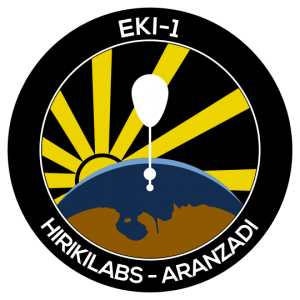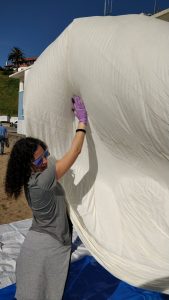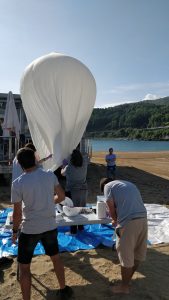The stratospheric mission EKI1 arose as a collaborative project within the Hirikilabs open group of citizen astronomy with the aim of carrying out the first launch of a stratospheric probe that would allow us to collect data and take pictures of the environment and learn the necessary skills to achieve this objective as a community, skills that will later help us to plan future more ambitious missions.
For this first mission, it was proposed to achieve several goals, in the following order:
- Real-time flight tracking
- Obtaining data from the environment
- Obtaining images of the entire flight
- Retrieval of the probe
For this reason, the project is divided into several subsystems: launch, recovery, telemetry, image and experiments.
- Launch covers the structure of the probe and everything related to the necessary material, balloon, helium, ropes, capsule and insulation, etc.
- Recovery covers the parachute system and flight tracking.
- Telemetry covers obtaining data and sending it in real time.
- Image covers capture and processing of photos and video.
- Experiments covers the added payload in the form of possible science experiments.
Mission
The launch took place on 7 September 2019 from Malkorbe beach, in Getaria. EKI-1 landed two-and-a-half hours later in Gaztelu, near Tolosa, after travelling 35 km horizontally and reaching a height of 32 km before exploding. Although there were small failures in different parts of the process, the capsule was tracked by means of the telemetry system and successfully retrieved along with the flight data. In addition to the videos and images, we were able to extract the telemetry data which included solar radiation, the graph for which can be seen in the photo gallery.
A follow-up EKI2 mission is in progress, correcting the failures identified in the first launch, in order to finish validating all the systems developed and to be able to propose future experiments to carry out.
Step by step

- Hyowee 1600 balloon . Helium canister (about 4.5 m3 minimum)
- Parachute (commercial model for about 1.5 kg or ripstop nylon to make one)
- Radar reflector (see designs) – 5 mm foam board, aluminium foil and adhesive spray
- Polyamide kite strings . Hollow polystyrene spheres (25 and 15 cm in diameter)
- Cameras: Xiaomi Yi 360 VR, SJ4000, Mobius, RPi Camera V1 . APRS NanoTracker
- Flight computer: Raspberry Pi Zero + StratoZero PCB (See main hardware)
- Experiment: Arduino + Geiger Counter + SD Logger
For the tracking receivers:
- TTGO ESP32 + LoRa + OLED boards (868MHz)
- Yagi 868 MHz antennas – 4 mm aluminium rods, 6 mm aluminium square shaft, 3D printed parts (see designs), coaxial cable.
Flight computer: Raspberry Pi Zero with the StratoZero hat:
ASHAB-RS software that runs on the Raspberry Pi:
Tracking software for the computer:
https://github.com/ladecadence/ASHAB-Telemetry
Software to install on a server to enable online tracking and database reception:
https://github.com/ladecadence/Helios
Software for the TTGO+OLED+LoRa boards:
Design of the parachute (Ripstop Nylon): Parachute
Radar reflector design (Cut out of foam board and cover with aluminium foil): Radar reflector
Reception/transmission antennas: 868 antennas
LoRa antenna for the capsule: 868-double-dipole








